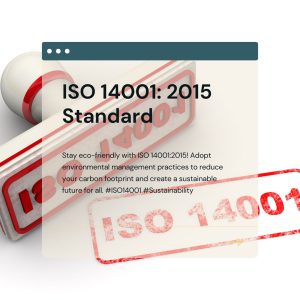ISO 14001:2015

With the needs and regulations becoming tougher day by day to protect the environment by creating awareness to environment obligations, organisations require assistance to install an Environment Management System (EMS), Providence, with its trained and qualified counsellors provide the necessary assistance in the development, installation and implementation of Environment Management System (EMS). We has helped number of organizations in this attempt and has set an impression in the minds of the clients the knowledge it can impart in developing an excellent system complying to this latest updated standard.
Why get ISO 14001:2015 Certified?
ISO 14001:2015 is an internationally recognized Environmental Management Systems (EMS) standard. Here are the key reasons why organizations pursue this certification:
- Environmental Performance Improvement: The standard helps organizations reduce their environmental impact by providing a framework for better resource management, waste reduction, and energy efficiency.
- Regulatory Compliance: ISO 14001:2015 ensures that companies stay up-to-date with environmental laws and regulations, minimizing the risk of legal non-compliance and penalties.
- Enhanced Reputation: Certification signals to customers, partners, and stakeholders that the organization is committed to sustainable and environmentally responsible practices, boosting public perception and trust.
- Cost Savings: Improved energy efficiency, waste reduction, and better resource management often lead to significant cost savings over time.
- Competitive Advantage: Many clients and governments require suppliers to have ISO 14001 certification, making it a competitive advantage in tenders and contracts.
- Risk Management: The standard helps in identifying and mitigating environmental risks, preventing incidents, and improving the organization’s overall risk profile.
7. Employee Engagement: An effective environmental management system can improve employee morale and involvement by demonstrating a commitment to sustainability.
Steps to ISO 14001:2015 Certification
- Familiarization and Planning:
- Understand the ISO 14001:2015 standard by reviewing its requirements.
- Secure top management support for implementing the Environmental Management System (EMS).
- Define the scope of the EMS and environmental policy for your organization.
- Gap Analysis:
- Conduct an initial assessment to identify gaps between your current environmental practices and the ISO 14001:2015 requirements.
- Develop an action plan to address these gaps.
- Training and Awareness:
- Train key employees and stakeholders on the principles of ISO 14001 and the specific changes required.
- Build awareness across the organization regarding environmental responsibility.
- Develop and Document the EMS:
- Create the necessary EMS documentation, including environmental policies, objectives, procedures, and work instructions.
- Establish monitoring and measurement processes for key environmental aspects (e.g., waste, energy consumption).
- Implementation:
- Implement the EMS across your organization, ensuring that employees follow the new processes and procedures.
- Ensure ongoing monitoring, measurement, and evaluation of environmental performance.
- Internal Audits:
- Conduct regular internal audits to assess the effectiveness of the EMS.
- Address any non-conformances found during audits and continuously improve the system.
- Management Review:
- Conduct a formal review of the EMS with top management to ensure that environmental objectives are being met and to consider opportunities for improvement.
- Certification Audit:
- Contact an accredited certification body to schedule an external audit.
- The certification audit will typically involve a two-stage process:
- Stage 1 Audit: A preliminary review of your documentation and processes to ensure they are ready for full assessment.
- Stage 2 Audit: A comprehensive audit to confirm that your EMS is fully implemented and compliant with ISO 14001:2015.
- Certification and Ongoing Surveillance:
- Once the organization passes the certification audit, it will receive the ISO 14001:2015 certification.
- Certification is typically valid for three years, during which periodic surveillance audits will be conducted to ensure ongoing compliance.
